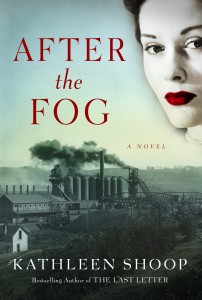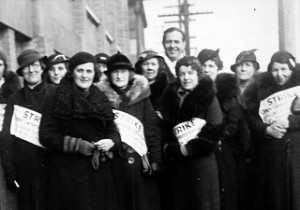Characters Welcome
By Guest | May 15, 2012 |
Today’s guest is bestselling Kindle author Kathleen Shoop. Her second historical fiction novel, After the Fog, is set in 1948 Donora, Pennsylvania. The mill town’s “killing smog” was one of the worst environmental disasters in U.S. history, triggering clean air advocacy and eventually, the Clean Air Act. Kathleen’s debut novel, The Last Letter, sold more than 50,000 copies and garnered multiple awards in 2011, including the Independent Publisher Awards Gold Medal. A Language Arts Coach with a Ph.D. in Reading Education, Kathleen lives in Oakmont, Pennsylvania with her husband and two children.
For every woman who thinks she left her past behind… Rose Pavlesic is a straight-talking, gifted nurse who is also controlling and demanding. She has to be to ensure her life is mistake-free and to create a life for her children that reflects everything she missed as an orphaned child. Rose has managed to keep her painful secrets buried, away from her loving husband–who she discovers has secrets of his own–their children and their extended, complicated family.
But, as a stagnant weather cycle works to trap poisonous gasses from the three mills in town, Rose’s nursing career thrusts her into a conflict of interest she never could have fathomed–putting the lives of her loved ones at risk and forcing her to come face to face with her past.
Kathleen’s exhaustive research for After the Fog included reading volumes of nursing reports and handwritten/typed accounts of what community/public health nurses did for a living. Her research also included the Nursing Manual: Public Health Nursing Association of Pittsburgh (1941), Community Health Association: Nursing Technique (1930) and the Donora Historical Society. Here, she provides insights into crafting characters from clay to when they take their first breath. Enjoy!
Characters Welcome
Crafting characters is one of the most enjoyable parts of writing a novel. Authors want their characters to leap off the page, sit beside readers, and yank them through the story by the hand.
When I break out the literary clay, I can’t help but think of USA Network’s tagline, “Characters Welcome.” To sculpt the people of my books I explore their pasts, career paths, and the historical context of the setting. For example, considering issues such as traditional gender roles of the time and studying the bold outliers who defy expectations for their era. Simple enough.
But, being a messy drafter, this process takes patience with the layering of traits, habits, and actions. Take Rose Pavlesic, my main character in After the Fog. To me she lives and breathes. Rose is brash, no nonsense, smart, and desperate that her children don’t make the same mistakes she did. Oh, and she’s a mac-truck-turning-around-in-a-peaceful-cul-de-sac insensitive. But she cares to her core about the people she loves. Let’s take a look at what elements helped me mold her character:
Setting: 1948 Donora, Pennsylvania—a steel-mill town in the midst of one of America’s worst environmental disasters. This event, the “killing smog,” spurred the founding of the EPA and the 1955 Clean Air Act. This setting shaped much of Rose’s personality. Yes, there were demure, kittenish women living in mill-towns, but the women I knew (even decades after this event) weren’t them. And my research supported my anecdotal experience.
The women who ran mid-20th Century homes in towns like Donora were tough as the nails manufactured at the bottom of the hill. They had little time for coddling and praising people for things they should’ve been doing all along. They worked ‘til their hands shook with fatigue. They took pride in their homes—even if they slapped them together as their families grew and couldn’t keep the soot off the curtains, countertops, and doorjambs.
They cooked for husbands who worked all night and slept off the post-shift shots and beers all day. They quieted spirited children and encouraged education. Their language could be clipped and harsh. I tempered Rose’s hardness through affectionate moments with her husband and children—brushing her daughter’s hair each morning was something she looked forward to as much as eating. Rose’s Past: As with any character that is stone-pillar strong, there are cracks in the plaster. While the reader sees snippets of Rose’s early years, I needed to fully understand why she might be a patient’s greatest comfort and her children’s least favorite parent. What happened to Rose to make her scrappy, abrasive, and hard to like by the people she loved most?
Rose’s Past: As with any character that is stone-pillar strong, there are cracks in the plaster. While the reader sees snippets of Rose’s early years, I needed to fully understand why she might be a patient’s greatest comfort and her children’s least favorite parent. What happened to Rose to make her scrappy, abrasive, and hard to like by the people she loved most?
Rose’s life in the orphanage left her secretive and untrusting. After being “rescued” by a kind-hearted nun, Rose found her calling: nursing. Nursing provides her with security, a feeling many people find in intact families.
A Character’s Work: As a community nurse, Rose’s need to be needed fulfills her humanity. Rose’s profession gave me the opportunity to put her in the homes of Donora citizens, an eyewitness to the suffering. While shuffling through town during those dark days, Rose pieces together the worsening events, giving the reader insight into why so few people reacted to the alarming situation until too late.
Creating faceted characters—it’s the task of any writer. Rose is an amalgamation of so many women I knew in life and studied through this process. Love her or hate her, my hope is that she causes a stir. For a bold woman is a sight to behold.
Who is your all-time favorite, brazen female character in a book? What makes her strong and unforgettable?
Keep up with Kathleen and find out more about After the Fog on her website, Twitter and Facebook.











A wonderful illumination of a wonderful subject: character creation. I was struck by two words you used: ‘sculpt’ and ‘amalgamation’. Couldn’t be better at revealing the essence of character creation.
PS: You also twanged a memory string with your reference to ‘mac truck’ as I had visited and toured the Mack Truck plant in Allentown, PA. It was then (during the ’60s) an iconic, proud, familial operation but has long since been absorbed by other enterprises.
Hi Alex, thank you for your comment. I agree with you that “sculpt” is a telling word–at first the process seems flat, but as the drafting goes on and the layers are added, the characters do take on a three-dimensional feel to me. I hope they do to the readers!
Kathleen,
Congratulations on your book. For some reason it made me think of Baker Towers by Jennifer Haigh, also set in a Pennsylvania coal town. Favorite female protagonists for me include Lisbeth Salander and Hermoine Granger, two very different characters who in their own way were able to impose their will on others. I wish you the best with your book.
Thanks so much for leaving your thoughts, CG. It’s funny you mention Baker Towers because I just found that book a week back and am reading it now. Wow, reading it makes me glad I didn’t find it before I wrote my book. She’s amazing of course and I love her subtle style–less heavy-handed than mine! But, the era is similar and it’s a pleasure to read her work! Thanks for the good wishes.
Crafting characters who are engaging and memorable, flawed but sympathetic, is so important. Thank you for sharing some insight into how you’ve done this successfully with a complicated character like Rose.
Hi Roxanne, thanks so much for your comment! I sure hope I succeeded in doing what I set out to do. It’s tricky for sure and luckily I had a great editor who provided the right set of eyes to ensure that everything said and done was purposeful!
So glad you gave the backgrounder to this task of developing a character for historical fiction, the need to do the research to add authenticity and “character” to your character.
Congrats!
Thanks, Patricia. It’s a joy to do if you like that kind of thing! Good luck with your work!
Two “unlikeable” but highly compelling and surprisingly sympathetic characters that stick out for me are Victoria in LANGUAGE OF FLOWERS by Vanessa Diffenbaugh (that book is magic) and Vivi in DIVINE SECRETS OF THE YA YA SISTERHOOD by Rebecca Wells. Both damaged young women with demons who do the best they can (which isn’t always so great…).
Kristan, yes! I really appreciate “unlikeable” characters as long as I begin to see the underpinnings of what makes them bristly. The trick, of course, is that not everyone thinks the same things are attractive or funny, etc. Thanks so much for your comment.
Was Vivi the bad mommy one? Can’t remember and can’t find the book right now…
Facets are what make characters come alive! Without them, characters are flat and one-dimensional. With them, even unlikeable characters can be made sympathetic and compelling and…well, more likeable. With them, too-perfect characters can be given flaws and depth and complexity and made less cloying. Yes, I like facets.
My favorite brazen female character in a book is Ayla from THE CLAN OF THE CAVE BEAR. (Through the first two books in the series, at least. Eventually she got a little Mary Sue-ish for my taste.) She goes through a ton of adversity as a girl, growing up in a society where she doesn’t belong and experiencing terrific abuse (as well as love from a few adoptive family members). She grows to overcome it and uses the qualities her tribe sees as odd to survive when she is cast out. She’s tough and she’s odd, but she’s very human, capable of deep emotions and compelling narration. I love her so much.
Thanks for sharing your favorite gritty character! I agree she’s a great one!
My favorite “gritty female” character is Ree Dolly, in “Winter’s Bone” by Daniel Woodrell. She is a sixteen year old girl who has a meth-hooked daddy, a mentally ill mama, and two younger brothers to take care of. She has to save the family home and goes out to prove that her daddy is dead so that they don’t lose their house. This character could easily devolve into a stereotype, but doesn’t. She is strong and brave yet believable and doesn’t come off as too good to be true. A wonderful book, beautifully written, that serves as a guide for a realistic strong female character.
I look forward to reading your book, Kathleen. Thanks,
Hi Christine, I still need to read that one. I just put it on my kindle at your mention. Ree sounds fabulous. That’s the trick, I think–the balance that keeps the character from being too good to be true! Wonderful characters mentioned here!
I love reading books by authors who want to make a difference, who want to get readers thinking. It’s interesting that CG Blake mentioned Hermione Granger. I don’t think she would have come to mind, but I can see the justification for her being on the list. I’m not sure that I’ve read the ultimate female character, but Princess Leia in Star Wars comes to mind. But my questions has always been, do you need to be a woman to write strong female characters and a man to write strong male characters?
Ronda,
I think James Alexander McCall writes strong and convincing female characters. Precious Ramotswe in his #1 Ladies Detective Agency series, for one.
Diana Gabaldon writes strong male characters in her Outlander series.
Just the first two examples to spring to mind.
Correction: Alexander McCall Smith is the name of the first author I mentioned.
I know who I had on the brain when I wrote that. Diana Gabaldon’s James Alexander Malcolm MacKenzie Fraser!
Katniss from The Hunger Games comes to mind.
I can relate to your messy drafting, Kathleen. Though I know a lot about my characters going in, having spent some weeks or months thinking about them and plotting out their story, still it’s in that first draft that I learn how vague my initial concept of them was. It requires many pauses in the process to rethink what I think I know about them, so that my first drafts are written rather slowly.
It’s an exhilarating, frustrating, soul-consuming process of discovery, creating a cast of characters. As hard as I work at it, as deep as I dig for traits and motivations, stitching together back story and quirks, strengths and flaws, there’s still an element of character creation that happens beneath my fingertips, as the words scroll out on any given day, that is still a mystery to me after twenty years of writing fiction.
Hi know, Lori! There are times I’d love to be able to proceed neatly (I know an author who writes one draft–each sentence crafted to her specs 1st time then off to editor) but I just can’t do it. I have to get the material on paper before I can craft the real thing!
I thoroughly enjoyed this piece on how you “sculpt” and “mold” this character, and how you emphasize the process of layering her with habits and traits. I have gained far more insight from this one article than by some of the whole books I’ve read. And I love the metaphor of Mac-truck turning in a peaceful cul-de-sac to describe her personality- and that you understood that you needed to add “elements” that make her “faceted” rather than one dimensional.
Finally, your need to “fully understand” why she is such a comfort to her patients, but her children’s least favorite parent resonated most with me. It describes my mother- she and I did not have a good relationship early on, because she was harsh and strict, and that affected the way I viewed myself. Now that I am gearing up for edits on my first book- in which I create a mother similar to mine- I struggle with how to depict her toughness without conveying her as a monster. The small detail of Rose combing her daughter’s hair every morning was a nice reminder that it doesn’t take much.
You should consider writing a small book on character “sculpting”. You lay out the job very well and fluidly.